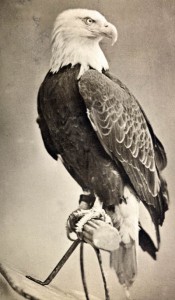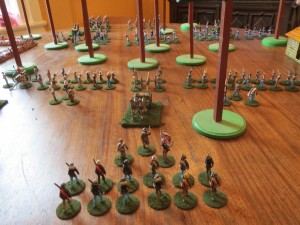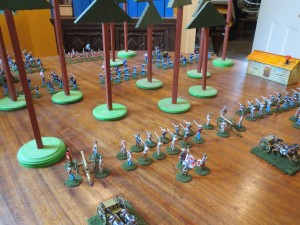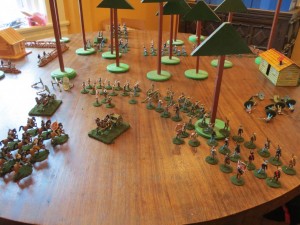Two. Count them, two posts in a single day!
This post came about after reading a question Why Game the SYW? posted over on the The Miniatures Page
I already had this short piece in my queue for posting, so I figured why not post it now? It winds up being at least somewhat topical.
FORGET ABOUT NAPOLEON:
THE CASE FOR EIGHTEENTH CENTURY WARGAMES
by Aram Bakshian, Jr.
Table Top Talk, September 1966
I don’t doubt for a moment that the majority of wargamers are Napoleonic buffs… I just regret it. And, at the risk of offending some of the harder cases, I am entering this brief plea for another period.
One author has called it the “century that sparkled,” and indeed it did. Militarily, it was the age of splendid uniforms, elaborate formations, ingrained spit-and-polish, and officers were usually gentlemen amateurs. Since most of us are amateurs, if not gentlemen, we have at least one automatic link with the generals of this delightful era.
The scope is tremendous. I can think of a dozen different wars offhand… there were many more. Each one was distinctly different. Battles were fought from one side of the globe to the other. Sepoys and elephants, garlic – belching Corsican mountaineers, wild pandour and grenz infantry, Cossacks and Tartars, and, of course, the mighty regular armies of Europe, each with distinctive uniforms, drill and tactics, and an assortment of generals that would rival any gallery of great geniuses and eccentrics.
Like wars on the tabletop, the real wars of this period were usually fought over trifles. No blithering about a “people’s war”; no pushy little Corsican telling Frenchmen how to be patriotic and endlessly haranguing about “la gloire” (which was, incidentally, invented under the old regime).
Perhaps the greatest tribute which can be paid the 18th century is that it gave birth to nearly all the great men and ideas of the Napoleonic era. The sleek canons of Gribeauval, the daring and imaginative use of light troops, experimentation with line and column; the list is endless.
One final irony. The British Army was the true product of the 18th century, and Wellington was the very model, of the 18th century officer and gentlemen (both his virtues and his faults reflect this). Together, they managed to trounce you-know-who rather nicely!
All this by way of arguing that information on this period would be of interest to many readers, especially after the recent massive Napoleonic over-dose!







